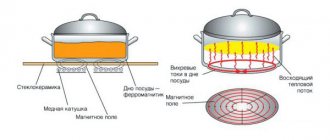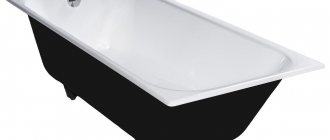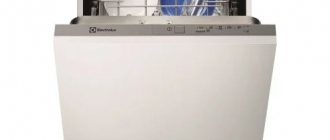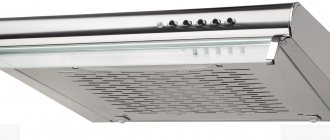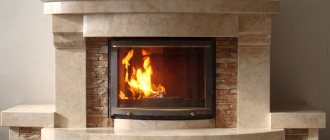A functional, ergonomic and stylish hob is the dream of every housewife .
Thanks to the variety of devices presented, buyers have the opportunity to purchase a high-tech and reliable device that will fully meet the requirements of experienced consumers .
The only problem is which model to choose: electric or induction, and what are their differences.
Page navigation:
Operating principle and features of electric hobs
Stay up to date! The operating principle of electrical surfaces is based on the passage of electricity through a resistor that releases thermal energy.
When current passes through the heating elements, the coil gradually heats up, transferring heat to the surface of the electric burner.
Only after this the dishes placed on the panel and their contents will begin to heat up.
Among the many advantages and features of electric hobs , the following points can be highlighted:
- smooth heating process and quick cooling of the burner;
- absence of difficult-to-clean cast iron grates;
- the ability to use dishes of various shapes;
- presence of automatic boiling;
- heating the dishes, not the surrounding area;
- no need for special care;
- wide range of design and color solutions.
What is the difference between an electric hob and an induction hob?
When it comes time to change or purchase a hob based on electricity consumption, many are faced with a choice, what to choose?
If there are usually no problems with color, size and design, then the choice between an electric and induction panel makes many people ask themselves what the difference is.
In this article we will compare electric and induction hobs. Let's identify the differences, pros and cons of one option or another and summarize the results of our analysis.
The main difference is the operating principle
Many people think that the main difference between induction and electronics is that the first is “smart” and includes many functions, while the other is simpler. In some ways, this thesis is certainly correct, but still few people know that these devices have a different heating element.
The electrical panel is heated by the flow of current. That is, first the panel heats up itself and only then the dishes. Induction surfaces produce heating using a magnetic field originating from a special coil located under a glass-ceramic coating and immediately heats the bottom of the container.
Advantages and disadvantages
The main advantage of an electric cooktop is its power. But this also comes with a minus: its electricity consumption is much higher than that of induction.
For example, in the IK 60.0 KEL model with induction heating, the electricity consumption is 6.8 kW, which is considered a small indicator for such a model.
Unfortunately, there are also disadvantages. Induction panels require special cookware with ferromagnetic properties. To check if your pots and pans are suitable, just hold a magnet to their bottom; if it sticks, then everything is in order, if not, then you will have to separate. Fortunately, most cookware manufacturers have long taken this feature into account and now you will rarely find one without this property. Sets left over from parents and grandmothers made in the USSR are also suitable for induction, since they were produced among peaceful products with military ones src=»https://Graude-store.ru/upload/medialibrary/7b4/hob_graude_ik600kel_1.jpg» class=» aligncenter" width="482″ height="425″[/img]
Caring for both electric and induction panels is very simple. They all have a smooth surface without protrusions or grooves like some gas surfaces designed for cooking grates. It is enough to wipe them with a damp cloth or use special products designed for these types of equipment.
A distinctive feature of the induction panel is its safety. The degree of protection has several levels. Firstly, it automatically turns off if there are no dishes on it. Secondly, if there are foreign objects on it (spoon, napkin), it will not work, not recognizing the outlines of containers in these objects. By the way, thanks to this system, it does not spoil the dishes, starting heating only with containers that have contents. Therefore, you don’t have to worry about burning the kettle if there is not enough water; the panel will warn you with a sound signal.
Electric surfaces retain heat very well; due to the fact that it cools slowly, a residual heat function was developed. When you're done cooking, the hot areas will turn a bright red color, helping you avoid getting burned and using up any remaining energy. For example, melt a piece of butter or chocolate, warm up a sandwich or a bowl of soup.
Based on the above, small conclusions can be drawn.
Pros of induction:
•Economical energy consumption •Safe to use •Food does not burn on the bottom of the dish due to the operating principle
Electrical advantages:
•Suitable for any utensils •Always keeps warm •Easy to clean
Electrical panels are simpler and more powerful, suitable for people who do not like “extra” functions and are accustomed to simple controls. For those who switched from gas to electricity, this is the most acceptable option.
Families with children and elderly people will appreciate induction surfaces with their increased safety system. The panel locking and dish recognition functions will be indispensable in a large family. Fans of modern innovations may not look for other options, since this type of heating is considered the most progressive.
In conclusion, I would like to say that the more modern the technology, the more advantages it has in comparison with outdated models. It’s up to you to decide whether to buy an induction or electric hob, depending on your personal preferences and needs.
Operating principle and features of induction hobs
The mechanism of action of induction hobs consists of the operation of special pre-installed coils - under the influence of electricity, they create a powerful high-frequency magnetic field.
Important! As a result, when the coils located under the surface are activated, the process of heating the cookware with ferromagnetic properties begins.
While heating kitchen utensils, the panel remains cold, which means the risk of getting burned is minimal.
the main features of induction hobs:
- instant heating of installed pots and pans due to induction coils;
- quick change of temperature to the level required by the user;
- automation of many processes and ease of cooking;
- belonging to a high energy efficiency class;
- absence of foreign odors during operation;
- operation of the surface only in the presence of utensils installed on it.
Content
- How the hob works
- Choosing a hob depending on the dishes
- Cookware heating speed
- Noise from heating and panel operation
- Hob safety
- The influence of the hob on other appliances
Choosing a hob is an important stage in kitchen equipment. The problem of choice is especially acute for those whose home is not connected to a centralized gas supply. Increasingly, the choice is made between electric and induction hobs. Both have their own characteristics that need to be taken into account when purchasing. Let's compare the main characteristics of these two types to make your choice easier.
Advantages and disadvantages of models
You should know! Universal electrical surfaces are famous for the following advantages:
- ease of management and maintenance;
- simple independent connection of equipment;
- ability to withstand high temperatures;
- presence of energy saving mode;
- a sufficient set of functions for comfortable cooking;
- no need to purchase new suitable utensils;
- acceptable cost.
The disadvantages of electrical panels include expensive repairs in the event of malfunctions or breakdowns, as well as suspension of the work process when liquid gets on the surface.
Improved induction models also have many advantages , including:
- economical energy consumption;
- intuitive controls;
- instant heating and quick cooling of the burners;
- high level of security;
- wide choice of power control levels;
- rapid temperature change accurate to one degree;
- impossibility of heating if there is no cookware on the burner.
However, induction-type devices also have disadvantages :
- the need to use special utensils;
- connection difficulties;
- high price.
Electrical panels
The very first models appeared around the end of the 19th century. At that time, such a device was revolutionary and was the most powerful household electrical appliance. However, it was unsafe, because... the surface was heated to very high temperatures, and the protection systems were either very banal or absent altogether.
Modern electric stove Zanussi ZEV 6646 XBA with Hi Light burners
Today, electrical panels come in many types and vary in many ways. For example, there are devices with electronic touch controls, and there are models with conventional rotary switches. There are also stoves based on simple spirals and halogen heaters, and there are induction hobs - they are a type of electric hob.
Comparative characteristics
To figure out which panel is better and how they differ, let’s look at the table that compares the devices.
| Characteristics | Electric stove | Induction cooker |
| Heating rate | The cookware heats up in a couple of minutes | Heating occurs in a few seconds |
| Dishes | Utensils of different shapes are used | Use dishes with ferromagnetic properties and a smooth bottom |
| Control | Available in both touch and mechanical controls | Touch adjustment |
| Safety | There is a small chance of getting burned | The device is safe, but is not recommended for use by people with installed pacemakers |
| Energy Saving | Increased energy consumption | Low power consumption |
| Cleansing | Contaminants can be removed without much difficulty | Removing stains with a soft sponge |
| Noise | Low noise level | Quiet hum |
Which model is better to choose?
An induction hob is the best solution for people who want to save time and effort on preparing a variety of homemade dishes.
Important! Despite the fact that the equipment will cost a little more than the electric model, the user will appreciate the impressive range of options and operating programs that can significantly simplify the operating process.
It is worth choosing a more practical electrical device if there is no need for additional functions, and you do not want to spend a lot of time cleaning the device from complex contaminants.
How the hob works
Both induction and electric panels operate from the mains, but the principles of their operation differ significantly from each other.
- An electric hob functions as follows: passing through a resistor, electric current releases thermal energy, which is transferred to the cookware located on the heating element. This principle is typical for both old-style stoves with metal burners and modern models with glass-ceramic surfaces.
- The induction panel works differently: under the burner there is a high-frequency current generator that creates vortex currents in the cookware. In this case, it is not the burner that heats up, but the cookware itself, while the surface temperature of the stove and coil remains not too high.
However, the housewife who chooses between these two panels is more interested in how pleasant and convenient it is to cook on each of them. We will try to figure this out.
How to choose a hob depending on the dishes?
It is believed that almost any container is suitable for an electric surface, but for an induction surface you will have to buy a special one. This is not entirely true. Indeed, for the second, you need such devices in which food with ferromagnetic properties is prepared, that is, made with the use of iron. You can determine whether a particular pot or pan is suitable for use in the following ways:
- using special markings placed on the dishes by the manufacturer;
- using a regular magnet that reacts to metal containing iron: if the magnet is attached to the surface, then it can be used for an induction cooker.
You can also solve the problem with selecting dishes by purchasing a special adapter. It becomes a kind of conductor that acts as a heating element.
We recommend the FRABOSK induction hob disc
An electric hob also has limitations on the choice of cookware. It can heat effectively only if the size of the bottom of the pot or pan matches the size of the burner. The different sizes of burners provided on one electrical panel help to facilitate the selection of the necessary appliances.
TOP 3 best electric
#1
Bosch PKE611D17E
A device from a proven German brand that you can’t do without in the kitchen.
Glass-ceramic electric panel equipped with four burners of different diameters and a convenient front control panel.
The device has a well-thought-out security system and is equipped with a residual heat indicator, a countdown timer, and also has the ability to lock the controls from small children.
Specifications:
- rated power – 6.6 kW;
- switches – touch;
- burner timer – yes;
- Dimensions for installation: 56x49 cm.
Advantages
- high quality of materials and workmanship;
- elegant design without unnecessary details;
- keeping food warm;
- ease of cleansing;
- protective shutdown option.
Flaws
- When cleansing, stains may remain;
- ultra-sensitive sensor;
- The package does not include a plug.
#2
Hansa BHCI65123030
An attractive model with high consumer properties.
A durable four-burner hob with a slim silver frame for an interesting look.
The unit is equipped with an innovative protection system, so the user can safely prepare his favorite dishes for a large family.
Specifications:
- rated power – 6 kW;
- switches – rotary;
- burner timer – yes;
- Dimensions for installation: 56x49 cm.
Advantages
- residual heat indication;
- burners of different sizes;
- reliable security system;
- silent operation;
- Quite fast heating.
Flaws
- lack of display;
- lateral arrangement of switches;
- long cooling.
#3
Electrolux EHF 96547 FK
A modern kitchen assistant that can handle even complex tasks.
A glass-ceramic hob equipped with a residual heat indicator for safe cleaning, touch switches and the ability to pause the cooking process for a short time.
The four electric burners have different diameters, allowing you to use cookware of any size.
Specifications:
- rated power – 7.1 kW;
- switches – touch;
- burner timer – yes;
- Dimensions for installation: 56x49 cm.
Advantages
- high heating rate;
- long-term operation without breakdowns;
- work without noise effects;
- Ease of Management;
- sound notifications at optimal volume.
Flaws
- slight chemical smell;
- body contamination;
- length of electrical wire.
Distinctive parameters of induction and electric hobs
Important! An induction furnace is a type and more advanced analogue of an electric one. It combines all the advantages as much as possible and minimizes the disadvantages of the latter.
It is impossible to unequivocally answer the question which hob is better: induction or electric. The main thing in comparison is the individual needs and priorities of the user. Therefore, in order to choose the best option for specific goals and objectives, you need to compare both models.
Heating method
The main difference between these two panels is the method of heat transfer . In an electric stove, the heating element heats the surface of the burner, which heats the cookware. This role can be performed by:
- metal pancakes (the simplest model);
- spirals (rapid) - heat up quickly (from 10 seconds);
- tapes (Hi-Lite) - allow you to smoothly regulate the heating;
- halogen lamps used together with a spiral heat the burner almost instantly;
- electrical and gas components in one device (combined).
The essence of the operation of the electric panel is this: the surface of the stove heats up to 400°C, and then slowly cools down, allowing you to finish cooking after turning off the burner.
The heating element in an induction furnace is coils (high-frequency generator), which create a magnetic field on the surface of the burner without heating it. Once in this field, dishes with ferromagnetic properties begin to heat up. Heat is transferred directly to the food, excluding other elements of the stove: the burner (heating up to only 60°C is possible), the hob and the induction coil. The peculiarity of the induction hob adds a number of advantages:
- only the area of the cookware is heated, and not the entire burner;
- turns on only if the dishes occupy at least 70% of the burner area;
- heats up very quickly (you can boil a kettle in 2-3 minutes);
- saves electricity due to the absence of heat loss and rapid heating.
Informative: in addition to induction, there is another type of electric stove - infrared. Its heating element creates infrared radiation, which is absorbed by the liquid in the food, resulting in the release of heat that directly heats the dishes and the stove.
Utensils used
An electric hob allows you to use any heat-resistant cookware: from metal to ceramic or thermal glass. But you need to keep in mind that the bottom must be absolutely flat and smooth. Only under this condition will the products be heated evenly. However, as practice shows, the bottom of the dishes gradually deforms under the influence of high temperatures. In this case, you will have to periodically buy new pots and pans.
An induction cooker requires special cookware with ferromagnetic properties for its operation. Moreover, if you put a regular pan on the burner, it won’t even turn on. Therefore, to use this oven, you need to buy kitchen utensils with a magnetic bottom. You can also use an adapter for regular cookware, which is placed on the burner and heats up, transferring heat. But then all sense of using an induction field is lost.
Cooking speed
In modern electric stoves, the burner itself heats up quite quickly, unlike older models with a metal pancake or spiral. However, it takes a long time for the heat to transfer to the cookware. For example, it will take 15-20 minutes to boil a liter of water, and at least 7 minutes to heat a frying pan. Moreover, if you need to change the temperature during the cooking process, this will also take a lot of time. The electric stove heats up slowly and takes a long time to cool down. Thus, the products are still “languishing” in the dishes, reaching the desired state.
Induction furnaces do not have this drawback. Warming up the cookware takes almost the same amount of time as on a gas stove. You can increase or decrease the degree of incandescence quite quickly and easily by changing the indicator on the control panel. And almost immediately the inside of the pot or pan will be at the set temperature.
Safety
When it comes to safety of use, an electric hob is much inferior to an induction hob for several reasons.
- Getting burns. Since the electric oven gets very hot, there is always a risk of accidentally touching the burner or even just the surface nearby and getting burned. This is very dangerous if there are small children in the house.
- Fire safety. An electric hob can be a source of fire. For example, if you accidentally place a wooden cutting board or kitchen towel on a hot burner.
- Working conditions. An electric stove gives off heat not only to the dishes, but also to the air around it. If you cook several dishes at the same time without air conditioning in the summer, the kitchen turns into an inferno. In such conditions, the harm to health is obvious.
Important ! An induction furnace does not have all these disadvantages, but it also has its own nuances. Since it generates a magnetic field, this can negatively affect the health of people sensitive to such phenomena.
Ease of use
The process of cooking on modern hobs, be it electric or induction, is simplified as much as possible. The models are equipped with functions that allow you to automatically turn off the burners if there is no cookware on them. You can also set not only the temperature with an accuracy of 1°C, but also the cooking time, after which a signal will sound or the heat supply will stop.
Nowadays, manufacturers use glass-ceramic coating, which looks beautiful and protects well from dirt. The surface of the induction cooker does not heat up, so you can easily remove drops or debris with a damp cloth.
The situation is completely different with an electric oven. Firstly, all the liquid drops dry tightly to the hot burner, and pieces of food immediately burn and stick. Secondly, under no circumstances should you use abrasive cleaners to avoid scratching.
Advice! You need to handle sugar and salt very carefully over the electric stove. They can ruin the appearance of the surface, leaving behind noticeable scratches. And hot sugar can even change the structure of glass ceramics.
Noise
This indicator is completely absent in electric models. But induction surfaces are characterized by extraneous sounds of moderate intensity. This is due to the operation of fans that cool the high-frequency generator from overheating. Many users in their reviews claim that the crackling sound is quite quiet, and you quickly get used to it.
Economical
Thanks to the heating principle, induction cookers consume less electricity. There is virtually no heat loss during the cooking process, since only the bottom of the standing pan is heated, and not the entire burner area. Thus, energy costs will be one and a half times lower compared to an electric furnace.
Speaking of costs, it is necessary to note the cost of the stove itself. Induction analogues are much more expensive, which should also be taken into account when choosing the optimal model. If you don’t plan to cook a lot, then does it make sense to overpay for a more advanced and economical stove ?
Impact on other devices
An electric stove does not have any effect on other appliances, unlike an induction stove. Its magnetic field generated around the burner can affect electronics. There is a risk of magnetization of wristwatches, mobile phones and other small household appliances. In some cases, equipment may even be disabled.
Additional options
Manufacturers have tried to best meet the needs of users of both electric and induction cookers. To do this, they provided them with the following additional functions:
- shutdown when a certain temperature is reached - due to overheating;
- protection against small children by means of locking;
- de-energizing the burner when boiling over;
- timer programming (for delayed start, notification and shutdown);
- presence of status indicators near each burner.
How to use them correctly can be found in the video for a specific model.
Major breakdowns
The most common problem with an electric stove is the problem with turning it on. It can be caused by an open circuit: in the plug, socket, power cord, wiring or shield of the panel itself. Another option is that the burner or heating element has burnt out. These elements cannot be repaired, but only replaced with new ones. The third option is a problem with the power switch (repair or replacement is possible).
In induction cookers, breakdowns most often occur that are not related to technical malfunctions. For example, if the burner does not heat up well or does not turn on at all. This may be due to the size of the cookware placed on it. The bottom may occupy less than 70% of the area or may not adhere well to the surface; in both cases, the oven simply will not turn on. Perhaps the generator block does not adhere well to the glass-ceramic surface. In this case, it is worth adjusting the pressure springs or temperature sensor.
Advice! If the induction cooker itself does not work, then the problem should be looked for in the power switch or fuse. You should also check the contacts coming from the power board to the control unit and from it to the touch panel. One of these items may need to be replaced.
Average prices
The price range of a conventional electric oven is significantly different from an induction oven. For example, if you take the most primitive and small model with one heating element, then you can buy it on average from 600 rubles, and a more advanced analogue from 2000 rubles. As for a full-fledged glass-ceramic stove, consisting of 4 burners, its cost together with the oven starts from 15,000 rubles, while for induction from 50,000 rubles. And this is if we consider the most inexpensive brands.
TOP 3 best induction
#1
Electrolux IPE 6453 KF
An interesting model that has earned high marks from experts in the field of kitchen appliances.
Presented in a simple but ultra-stylish design, the hob features the ability to combine induction burners to create a single work area.
The surface is able to automatically recognize the presence of dishes, is compatible with kitchen utensils of any size and is ideal for installation in both large and small kitchens.
Specifications:
- rated power – 7.4 kW;
- switches – touch;
- burner timer – yes;
- Dimensions for installation: 59x49 cm.
Advantages
- auto synchronization of settings;
- changing the diameter of the burners;
- automatic hood control;
- convenient adjustment of modes;
- protection from children.
Flaws
- panel is too sensitive;
- rapid surface contamination;
- The device requires careful care.
#2
Bosch PIE631FB1E
A highly reliable device that combines German quality and attractive appearance.
An improved model with a built-in electricity consumption indicator and a power limiting function.
The design is equipped with a burner timer and is complemented by adjustment of sound signals - this option will be especially useful for families with small children.
Specifications:
- rated power – 7.4 kW;
- switches – touch;
- burner timer – yes;
- Dimensions for installation: 56x49 cm.
Advantages
- simple slider control;
- recognition of the presence of dishes;
- economical energy consumption;
- pausing the cooking process;
- strict design.
Flaws
- overcharge;
- no frame;
- You need to place the dishes carefully.
#3
Hotpoint-Ariston IKIA 640 C
A unit for independent installation that will complement the overall interior of the kitchen, making it more attractive.
Powerful induction glass-ceramic hob with four heating zones, smooth controls and an indicator to determine the surface temperature.
For safe and comfortable work, the manufacturer has equipped the design with a control panel lock button and backlight.
Specifications:
- rated power – 7.1 kW;
- switches – touch;
- burner timer – yes;
- Dimensions for installation: 56x49 cm.
Advantages
- frontal location of the control panel;
- residual heat indication;
- burners of different diameters;
- intuitive interface;
- laconic design.
Flaws
- silent sound notifications;
- easily soiled body;
- There is no oval heating zone.
conclusions
When choosing a hob, it is worth remembering several nuances and differences in devices:
- electric surfaces stand out due to their affordable price and sufficient number of programs , but may consume more electricity;
- induction models are characterized by increased safety , but are a little more expensive;
- Before purchasing a device, you need to pay attention to its dimensions, rated power and type of switches ;
- The presence of a timer and a long network cable will significantly simplify the operation process.
The difference between induction cooktops and simple electric ones
Despite the fact that induction panels are only one type of electric, for some reason they are usually separated as two separate types. We won't argue. There are differences between them:
- Induction panels are economical compared to conventional electric ones;
- They are also safer to use. Safety is mainly achieved by the absence of heating of the ceramic surface itself, which eliminates the possibility of getting burned. In the case of using a simple electrical panel, you should be very careful;
- When the induction coil operates, an electromagnetic field is created. It is likely to have harmful effects (electromagnetic radiation) on humans. Although this can be argued. We don’t know for sure whether this radiation affects humans and the food itself cooked on this surface;
- This type of electrical panels requires the use of special utensils. Most often, after purchasing an induction hob, you have to additionally buy special cookware. Ordinary cookware does not “know how” to effectively absorb the energy created by the electromagnetic field. In addition, modern induction cookers are quite “smart” and they do not turn on if they see that the wrong cookware is on the surface.
Of course, induction hobs are more technologically advanced and efficient when cooking. But they also cost more than simple electric stoves. By the way, there are now combined models on the market - with two regular Hi Light burners and two induction ones .
If you can’t decide between induction and electric models, then maybe you should pay attention to the combined option? Please rate the article:
